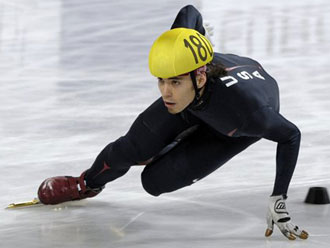Apolo Ohno Leads U.S. Olympic Short Track Hopes Again
By wchung | 19 Aug, 2025
The soul-patched one still glides low around the ice, powering past his rivals in the turns.
Apolo Anton Ohno is the leading contender to make his third U.S. Olympic short track speedskating team at this week’s national championships. Now 27, the five-time Olympic medalist remains one of the world’s best skaters in the unpredictable sport.
He’s easily the most famous person in this Upper Peninsula town on the shores of Lake Superior, with nonsports fans recognizing him from his 2007 victory on the ABC show “Dancing With the Stars.”
Winning the mirror-ball trophy rocketed Ohno into the pop culture stratosphere. While the Internet buzzed about his dating life, Ohno quickly resumed training with his focus on the Vancouver Games.
“He looks amazing,” short-track coach Jimmy Jang said Monday after practice at Northern Michigan University. “Everything is strong now. He’s very consistent with his technique, confidence, health, speed and power. He is better now than in 2002.”
That’s when Ohno became a breakout star during the Salt Lake City Games, winning a gold in the 1,500 meters and a silver in the 1,000. His wild and wooly sport was a nightly sellout, capturing the world’s imagination and prompting fans to don fake soul patches and bandannas.
Four years ago in Turin, Italy, Ohno added a gold and two bronze medals to his collection, tying him with long-track speedskater Eric Heiden for most medals won at the Winter Olympics behind speedskater Bonnie Blair with six.
Of course, Heiden’s haul came in a single Olympics, in 1980 at Lake Placid. Ohno can tie or claim the mark for himself in February in Vancouver, not far from his hometown of Seattle.
He declined to talk Monday, a day before the nine-lap and four-lap time trials that open this make-or-break meet, the first step toward earning a spot on the U.S. team. But Ohno was clearly in good spirits, smiling during breaks in practice and taking his turn using a squeegee to push excess water out of the racing path on the ice.
“Great to see/catch up with old friends at the ice rink today. Can’t believe I’ve been in the game since I was 13 years old! Almost 15 years!” Ohno said on his Twitter feed.
Previously held in December, when freezing temperatures and piles of snow provided a fitting backdrop, the trials were moved up three months to give the skaters more time to prepare for the Olympics. Canada will hold its trials in August. China and South Korea, the other top short-track countries, already have chosen their teams.
Apolo Ohno was raised by his Japan-born hairdresser father after he and Apolo’s mother divorced when Apolo was a child. His father encouraged Apolo’s interest in skating in hopes of keeping him from falling victim to unhealthy peer influences.
The top female skaters vying for one of five Olympic spots include Katherine Reutter, from Blair’s hometown of Champaign, Ill., and coming off a breakout season last year; 2006 Olympian Kimberly Derrick; and two-time Olympian Allison Baver, making a comeback after breaking her leg while crashing into the boards in Febuary.
Skaters will be vying not just for placement but for points, which sometimes can determine who makes the Olympic team.
“The biggest thing for any skater this week is don’t look at the points,” skater Ryan Bedford said. “Let the coaches figure that out. There’s no sense worrying yourself.”
The random nature of short track features plenty of falls and frequent disqualifications, so no one can take anything for granted.
“You can fall in the first time trial. Then you can do a re-skate and if you fall, you’re out,” said Bedford, who just missed making the Olympics nearly four years ago, finishing third in the 1,500, where only the top two qualified.
Ohno comes in as the overwhelming favorite, but the competition in the U.S. has gotten faster since Turin.
“He knows there’s a time and place he could get his butt whupped,” Bedford said.
Ohno’s best friend, Shani Davis, is focusing on long-track skating this time. Four years ago, he came up short in his bid to make both speedskating teams.
This time, Bedford will try to pull off the historic double. He has enjoyed his biggest success this year in relays, winning gold in the 5,000 at the short track world championships and earning a bronze in team pursuit at the long track world meet.
Bedford, of Midland, Mich., trains with Davis in Salt Lake City, and the Olympic champion has encouraged Bedford to accomplish what he didn’t.
“He wants to see somebody make it,” Bedford said. “He really believes I can do it.”
Bedford stands 6-foot and is 2 inches shorter than Davis. Height can be a disadvantage in short track, where smaller skaters can get lower to the ice and pass more easily in the tight confines of the 200-foot rink.
“Everyone is going to be gunning,” he said. “We’re probably the most unpredictable sport in the Winter Olympics. There is luck and bad luck. If you’re a good skater, you’re going to stay out of trouble.”
9/7/2009 6:08 PM BETH HARRIS, AP Sports Writer MARQUETTE, Mich.

Apolo Anton Ohno is the leading contender to make third U.S. Olympic short track speedskating team at this week's national championships. (AP Photo/Hans Punz, File)
Asian American Success Stories
- The 130 Most Inspiring Asian Americans of All Time
- 12 Most Brilliant Asian Americans
- Greatest Asian American War Heroes
- Asian American Digital Pioneers
- New Asian American Imagemakers
- Asian American Innovators
- The 20 Most Inspiring Asian Sports Stars
- 5 Most Daring Asian Americans
- Surprising Superstars
- TV’s Hottest Asians
- 100 Greatest Asian American Entrepreneurs
- Asian American Wonder Women
- Greatest Asian American Rags-to-Riches Stories
- Notable Asian American Professionals

